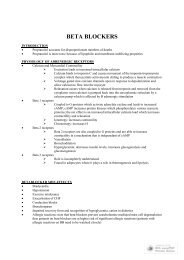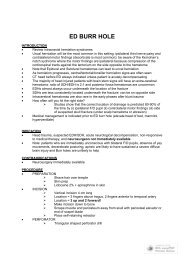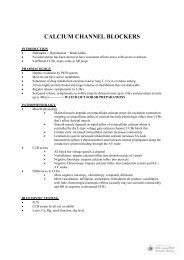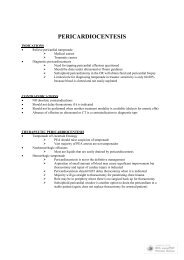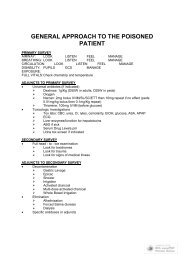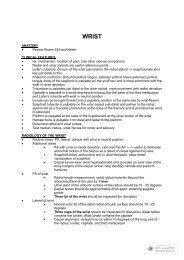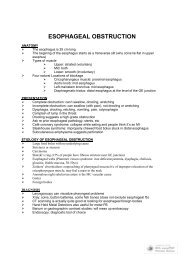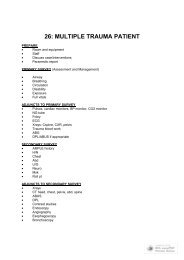ANTICONVULSANTS PHENYTOIN - rEMERGs
ANTICONVULSANTS PHENYTOIN - rEMERGs
ANTICONVULSANTS PHENYTOIN - rEMERGs
Create successful ePaper yourself
Turn your PDF publications into a flip-book with our unique Google optimized e-Paper software.
VALPROIC ACID<br />
INTRODUCTION<br />
Valproate, Epival, Depakene, Depacon,Depakote<br />
Di-n-propylacetic acid<br />
Uses: seizures, bipolar, migraines<br />
SR preparations are very common<br />
Common presentation of mild symptoms, discharged after few hours, delayed<br />
absorption and later crashes with decreased LOC 6-12hrs later due to delayed<br />
absorption (consider WBI)<br />
PHARMACOLOGY<br />
MOA: GABAergic effect (decreases degredation of GABA), some Na+ channel effects<br />
Therapuetic levels = 347 - 833 umol/L<br />
Complex metabolism in liver<br />
Valproic acid metabolism is dependant on carnitine as a cofactor (see 41-2 in goldfranks)<br />
‣ Complicated interaction with carnitine<br />
‣ Valproate DECREASES carnitine stores through various mechanisms<br />
‣ Carnitine depletion or deficiency decreases metabolism of valproic acid<br />
‣ Carnitine depletion has other metabolic effects: impaired transport of fatty acids,<br />
inhibition of ketoacid oxidation, and inhibition of the urea cycle resulting in an<br />
increased ammonia<br />
‣ Valproate therapeutic or overdose setting<br />
DECREASED CARNITINE<br />
INCREASED AMMONIA<br />
Adverse effects of Therapeutic dosing<br />
‣ Elevated liver enzymes<br />
‣ Toxic hepatitis --------> can be fatal<br />
‣ Reye’s syndrome<br />
‣ Hyperammonia<br />
‣ Carnitine deficiency<br />
CLINICAL MANIFESTATIONS<br />
Most are benign<br />
Hallmarks = COMA and RESPIRATORY DEPRESSION<br />
Neurologic<br />
‣ Decreased LOC<br />
‣ Ataxia, nystagmus, dyarthria do NOT occur<br />
Other<br />
‣ Increased Ammonia: 40% of those on chronic therapy, may occur after acute<br />
ingestion also, levels > 60 umol/L<br />
‣ Decreased Carnitine<br />
‣ Metabolic acidosis: secondary to lactate, can be severe, poor prognostic sign<br />
‣ Leukopenia, anemia, thrombocytopenia<br />
‣ Renal failure<br />
‣ Hepatotoxicity


